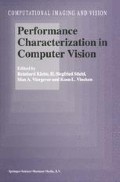Abstract
Computer vision as any other scientific field can be divided into theoretical and experimental parts. A set of reasoned ideas proposed in the theoretical part is verified by experiments. Furthermore, discernible discrepancies between theory and real-world facts and events are discovered during experiments. Thus, both theoretical and experimental parts are coupled creating a spiral on which a theoretical model is improved in the sense that discrepancies become smaller and smaller. The discrepancies are often measured by differences between theoretical and measured quantities if both are well established as they are in physics. However, we are still searching for such simple quantities in a number of fields including computer vision. The traditional solution is to define a set of performance indices and interpretation rules. From this point of view, it sounds rather curiously that performance evaluation of computer vision algorithms measuring discrepancies is not wide supported and must be still justified (Forstner, 1996).
Access this chapter
Tax calculation will be finalised at checkout
Purchases are for personal use only
Preview
Unable to display preview. Download preview PDF.
References
Allan, A.L. (1993) Practical Surveying and Computations,Butterworth-Heinemann Ltd, Oxford OX2 8DP, second edition.
Clifford, A.A. (1973) Multivariate Error Analysis, Applied Science Publishers Ltd, Ripple Road, Barking Essex, England.
Forstner, W. (1996) 10 pros and cons against performance characterization of vision algorithms, Christensen, H.I., Forstner, W. and Madsen, C.B. (eds.), Workshop on Performance Characteristics of Vision Algorithms, Proceedings,April 19, Cambridge, UK, 13–29, http://www.vision.auc.dk/-hic/performance-ws.html. Sponsored by European Network of Excellence in Computer Vision, http://afrodite.dist.unige.it.
Franceschini, F. and Rossetto, S. (1997) Design for quality: Selecting a products technical features. Quality Engineering, 9 (4): 681–688.
Garvin, D.A. (1996) Competing on the eight dimensions of quality, IEEE Engineering Managament Review, pages 15–23, Spring 1996.
Hall, T. and Wilson, D. (1997) Views of software quality: a field report, IEE Proceedings Software Engineering, 144 (2): 111–118.
Haralick, R.M. (1994) Propagating covariance in computer vision, 12th International Conference on Pattern Recognition (Jerusalem, Israel), volume I, IEEE Computer Society Press, Washington, DC, 493–498.
Heath, M.D., Sarkar, S., Sanocki, T. and Bowyer, K.W. (1997) A robust visual method for assessing the relative performance of edge-detection algorithms, IEEE PA MI, 19 (12): 1338–1369.
Khattree R. (1996) Robust parameter design: A response surface approach, Journal of Quality Technology, 28 (2): 187–198.
Kolarik, W.J. (1995) Creating Quality: Concepts, Systems, Strategies, and Tools, McGraw-Hill, Inc.
Logothetis, N. and Wynn, H.P. (1989) Quality through Design, Experimental Design, Off-line Quality Control and Taguchi’s Contributions, Clarendon Press, Oxford.
Montgomery, D.C. (1991) Design and Analysis of Experiments,John Wiley and Sons, third edition.
Morisio, M. and Tsoukias, A. (1997) IusWare: a methodology for the evaluation and selection of software products, IEE Proceedings Software Engineering, 144 (3): 162–174.
Nedialkov, N.S. (1994) Precision control and exception handling in scientific computing, Master’s thesis, University of Toronto, Department of Computer Science.
Phadke, M.S. (1989) Quality Engineering using Robust Design, Prentice-Hall International, Inc.
Pyle, I. (1996a) Performance considerations in COMPLEMENT, IEEE Symposium and Workshop on Engineering of Computer-Based Systems, IEEE Computer Society Press, 206–213.
Pyle, I. (1996b) Quality in software based systems, IEEE Symposium and Workshop on Engineering of Computer-Based Systems, IEEE Computer Society Press, 214–218.
Ross, P.J. (1988) Taguchi Techniques for Quality Engineering, Loss Function, Orthogonal Experiments, Parameter and Tolerance Design,McGraw-Hill Book Company.
Taguchi, G. (1986) Introduction to Quality Engineering,Asian Productivity Organization, 4–14, Akasaka 8-chome, Minato-ku, Tokyo 107, Japan.
Taguchi, G., Elsayed, E.A. and Hsiang, T.C. (1989) Quality Engineering in Production Systems,McGraw-Hill Book Company.
Trivedi, K.S., Ciardo, G., Malhotra, M. and Sahner, R.A. (1993) Dependability and Perfomability Analysis, Donatiello, L. and Nelson, R. (eds.), Performance Evaluation of Computer and Communication Systems, Joint Tutorial Papers of Performance ‘83 and Sigmetrics ‘83, Springer-Verlag, 587–612.
Woodside, C.M. (1993) Performance Engineering of Client-Server Systems, Donatiello, L. and Nelson, R. (eds.), Performance Evaluation of Computer and Communication Systems, Joint Tutorial Papers of Performance ‘83 and Sigmetrics ‘83, Springer-Verlag, 394–410.
Zhang, Y.J. (1996) A survey on evaluation methods for image segmentation, PR, 29 (8): 1335–1346.
Author information
Authors and Affiliations
Editor information
Editors and Affiliations
Rights and permissions
Copyright information
© 2000 Springer Science+Business Media Dordrecht
About this chapter
Cite this chapter
Mařík, R. (2000). Quality in Computer Vision. In: Klette, R., Stiehl, H.S., Viergever, M.A., Vincken, K.L. (eds) Performance Characterization in Computer Vision. Computational Imaging and Vision, vol 17. Springer, Dordrecht. https://doi.org/10.1007/978-94-015-9538-4_4
Download citation
DOI: https://doi.org/10.1007/978-94-015-9538-4_4
Publisher Name: Springer, Dordrecht
Print ISBN: 978-90-481-5487-6
Online ISBN: 978-94-015-9538-4
eBook Packages: Springer Book Archive

